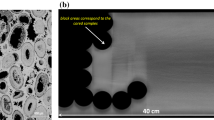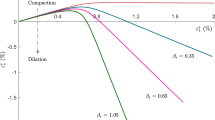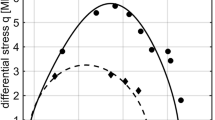Abstract
The mechanical behavior and permeability of the Tuffeau de Maastricht calcarenite were studied. Compactions bands were found to form in the “transitional” regime between brittle faulting and cataclastic flow. In order to predict the formation of compaction bands, bifurcation analysis was applied on a model developed by Lade and Kim. The numerical results proved to be in good agreement with the experimental ones where the localization point was identified to be the onset of shear-enhanced compaction (a threshold in differential stress after which significant reduction of porosity is induced). Before the onset of shear-enhanced compaction, permeability was primarily controlled by the effective mean stress, independent of the deviatoric stresses. With the onset of shear-enhanced compaction, however, coupling of the deviatoric and hydrostatic stresses induced considerable permeability and porosity reduction.
























Similar content being viewed by others
References
Baud P, Klein E, Wong T-f (2004) Compaction localization in porous sandstones: spatial evolution of damage and acoustic emission activity. J Struct Geol 26:603–624
Borja RI (2002) Bifurcation of elastoplastic solids to shear band mode at finite strain. Comput Methods Mech Engrg 191:5287–5314
Borja RI (2004) Computational modeling of deformation bands in granular media. II. Numerical simulations. Comput Methods Mech Engrg 193:2699–2718
Borja RI, Aydin A (2004) Computational modeling of deformation bands in granular media. I. Geological and Mathematical framework. Comput Methods Mech Engrg 193:2667–2698
Haimson BC (2003) Borehole breakouts in Berea Sandstone reveal a new fracture mechanism. Pure Appl Geophys 160:813–831
Haimson BC, Lee H (2004) Borehole breakouts and compaction bands in two high-porosity sandstones. Int J Rock Mech Min Sci 41:287–301
Haimson BC, Song I (1998) Borehole breakouts in Berea sandstone: two porosity-dependent distinct shapes and mechanisms of formation. SPE/ISRM, 229–238
Holcomb D, Olsson W (2003) Compaction localization and fluid flow. J Geophys Res 108(B6):2290–2303. DOI:10.1029/2001JB000813
Holt RM (1989) Permeability reduction induced by a nonhydrostatic stress field. In: paper SPE19595 presented at 64th annual technical conference, Soc. Of Petr. Eng., San Antonio, TX
Issen KA (2002) The influence of constitutive models on localization conditions for porous rock. Eng Fract Mech 69:1891–1906
Issen KA, Rudnicki JW (2000) Conditions for compaction bands in porous rocks. J Geophysical Res 105:21529–21536
Issen KA, Rudnicki JW (2001) Theory of compaction bands in porous rock. Phys Chem Earth (A) 26:95–100
Kim MK, Lade PV (1984) Modeling rock strength in three dimensions. Int J Rock Mech Min Sci Geomech Abstr 21(1):21–33
Kim MK, Lade PV (1988) Single hardening constitutive model for frictional materials. I. Plastic potential function. Comput Geotech 5:307–324
Kim MK, Lade PV (1988) Single hardening constitutive model for frictional materials. II. Yield criterion and plastic work contours. Comput Geotech 6:13–29
Klein E, Baud P, Reuschle T, Wong T-f (2001) Mechanical behavior and failure mode of Bentheim sandstone under triaxial compression. Phys Chem Earth (A) 26:21–25
Lade PV, Kim MK (1988) Single hardening constitutive model for frictional materials. III. Comparisons with experimental data. Comput Geotech 6:31–47
Lajtai EZ (1974) Brittle fracture in compression. Int J Fract 10:525–536
Molemma PN, Antonellini MA (1996) Compaction bands: a structural analog for anti-mode I cracks in Aeolian sandstone. Tectonophysics 267:209–228
Olsson WA (1999) Theoretical and experimental investigation of compaction bands. J Geophys Res 104:7219–7228
Olsson WA, DJ Holcomb (2000) Compaction localization in porous rock. Geophys Res Lett 27:3537–3540
Papka SD, Kyriakides S (1998) In plane crushing of a polycarbonate honeycombs. Int J Solids Struct 35:239–267
Park C, Nutt SR (2001) Anisotropy and strain localization in steel foam. Mat Sci Eng A299:69–74
Rhett DV, Teufel LW (1992) Stress path dependence of matrix permeability of north Sea sandstone reservoir rock. Proc US Rock Mech Symp 33:345–354
Rudnicki JW, Rice LR (1975) Conditions for the localization of deformation in pressure-sensitive dilatant materials. J Mech Phys Solids 23:371–94
Somerton WH, Solemnization IM, Duddy RC (1975) Effect of stress on permeability of coal. Int J Rock Mech Min Sci 12:129–145
Sternlof K, Pollard DD (2001) Deformation bands as linear elastic fractures: progress in theory and observation. Eos Trans Am Geophys Union 82(47):F1222
Sternlof KR, Rudnicki JW, Pollard DD (2005) Anticrack-inclusion model for compaction bands in sandstone. Journal of Geophysical Research 110:B11403, doi:10.11029/12005JB003764
Vajdova V, Baud P, Wong T (2004) Compaction, dilatancy, and failure in porous carbonate rocks. J Geophys Res 109:1029. DOI:10.1029/2003JB002508.
Wong T-f, Baud P, Clein E (2001) Localized failure modes in a compactant porous rock. Geophys Res Lett 28:2521–2524
Zhu W, Wong T-f (1996) Permeability reduction in a dilating rock: Network modeling of damage and tortuosity. Geophys Res Lett 23:3099–3102
Acknowledgments
The first author thanks Jørn Stenebråten for his crucial help in the experimental work. This work was conducted at SINTEF Petroleum Research, and received financial support from the EU project ’Degradation and Instabilities in Geomaterials with Application to Hazard Mitigation’ (DIGA-HPRN-CT-2002-00220) in the framework of the Human Potential Program, Research Training Networks.
Author information
Authors and Affiliations
Corresponding author
Rights and permissions
About this article
Cite this article
Baxevanis, T., Papamichos, E., Flornes, O. et al. Compaction bands and induced permeability reduction in Tuffeau de Maastricht calcarenite. Acta Geotech. 1, 123–135 (2006). https://doi.org/10.1007/s11440-006-0011-y
Received:
Revised:
Accepted:
Published:
Issue Date:
DOI: https://doi.org/10.1007/s11440-006-0011-y




